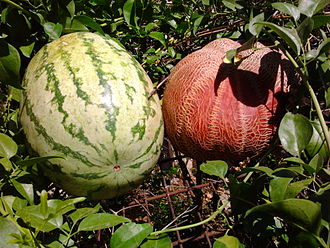How to Grow Melons – A Guide to Growing Melons
 Melon, including watermelons, can be successfully grown in the UK. They are a tender annual, suited to growing in containers or growbags. Melon are a vigorous climber – leave them to sprawl on the ground or provide a strong frame as a support and net the fruits to support them.
Melon, including watermelons, can be successfully grown in the UK. They are a tender annual, suited to growing in containers or growbags. Melon are a vigorous climber – leave them to sprawl on the ground or provide a strong frame as a support and net the fruits to support them.
Melons
- Ideally grow melons in the greenhouse or cold frame, in a rich, well-drained soil. They prefer a high humidity.
- If you have to plant them outside, try planting into your compost heap – the heat off the composting material will benefit the plant and encourage the fruits to ripen.
- Otherwise, plant outside in a sunny, sheltered position. It is a good idea to cover the ground with either black plastic sheeting or black weed-suppressing fabrice and plant through it (keep the edge of the sheeting/fabric away from the plant’s stalk). Protect the plants and ripening fruit with horticultural fleece or a cloche.
- Sow seeds 1 cm (1/2 inch) deep in late March/mid April, two seeds to a 7.5 cm (3 inch) pot, in a propagator or on a sunny windowsill (in which case cover the pot with clingfilm until the seedlings show). Retain the strongest seedling and pot on as required, although never move into an overly large pot.
- Harden off in late May/early June, but beware the danger of frost. Ensure the final planting position is in a rich, fertile moisture-retentive but well-drained soil. Melon are greedy plants so add organic matter and some general purpose fertiliser to the planting hole.
- Plant 50–90 cm (20–36″) apart and keep well watered.
- Pinch out the plants after the fifth leaf to encourage side shoots.
- Then select four strong sideshoots and remove all others. Pinch out the tip of each sideshoot after the sixth leaf.
- Give a liquid feed every 10–14 days.
- Remove any protective covering once the flowers appear to encourage pollination. Once small fruit have started to develop, remove all but the the best four on each stem.
- If the melon variety is not self-fertile, you may wish to hand pollinate – select 4–5 female flowers on each plant (the females flowers have a swollen part at the base of the bloom); pollinate them by placing a male flower inside each female (one male flower should pollinate four females).
- Although melons require plenty of water and feed to grow and produce flowers, cut back on the watering and stop feeding once the fruits start to swell and the foliage dies back.
- Remove any further flowers and new growth.
- If you are growing melon on a strong trellis, provide some support for the swelling fruit – a string bag or an old pair of tights supported from above will work. If you’re letting the plant sprawl on the ground, place a tile or a piece of glass under each fruit to prevent rotting.
Harvesting Melons
- You’ll know when the fruits are ripe by their sweet smell.
- Fruits with a netted skin (such as Galia) will come away easily from the vine and the skin becomes more yellow than green once fully mature
- Smooth-skinned fruits (such as Honeydew) must be cut from the vine. As the fruit ripens the skins become smooth and slippery, changing to slightly waxy once fully ripe. The skins may change colour and start to crack near the stem.
- Melons (apart from watermelon) can be cut slightly under ripe and left in a fruit bowl with bananas to ripen fully.
Pests and Problems with Melons
- Red spider mite can be a problem for greenhouse-cultivated melon. Keep the humidity high to discourage them.
- Downy mildew can also be problematic – shade the plants from strong sunlight.
Varieties of Melon
- Many different varieties of melon are available from the home-grower. Take a look in the allotment shop for those melon varieties with the RHS Award of Garden Merit.
Eating
- Melons are rich in vitamins A and C, and potassium.
- Melons should keep in the fridge for up to a week. The cut half of melon will keep for 3–4 days in the fridge but wrap it well as the flesh easily takes on other flavours.
- Melon makes a refreshing starter or dessert, or try it with cold chicken and mayonnaise, or in a rice salad.



